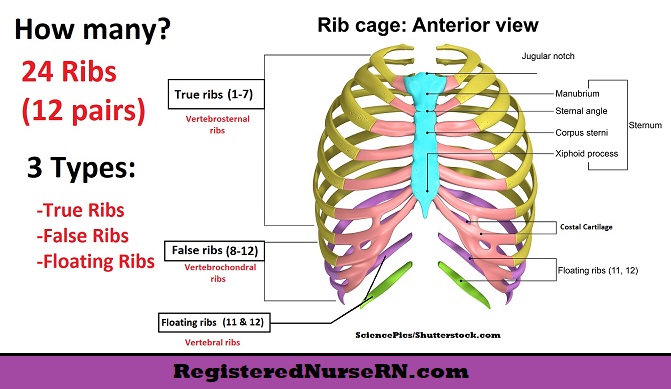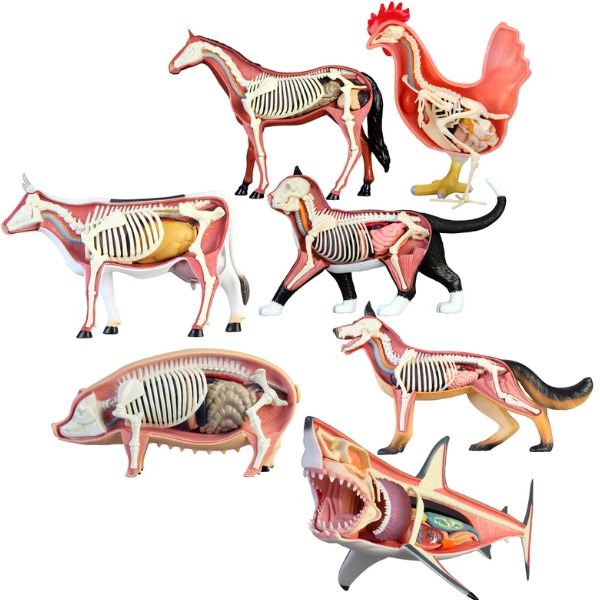
Introduction
A Brief Explanation Of The Importance Of Knowing The Rib Count
Knowing the rib count of different animals is essential for various reasons. It allows researchers and scientists to understand the anatomy and physiology of different species. Rib count can provide insights into the evolutionary history, body structure, and functions of these animals. Additionally, knowing the rib count can aid in distinguishing between different species and identifying potential hybrids or rare specimens.
The Range Of Rib Counts In Different Animals
The rib count can vary significantly among different animals, even within the same species. Here is a comparison of the rib counts in some commonly known animals:
| Animal | Rib Count |
|---|---|
| Cow | 13 pairs |
| Pig | 14 pairs |
| Sheep | 13 pairs |
| Chicken | 12 pairs |
| Cat | 13 pairs |
| Dog | 13 pairs |
It is important to note that these numbers represent the average rib count, and there can be variations among individuals. For example, some dogs might have one or two extra ribs, whereas others may have fewer. Furthermore, rib counts can also vary based on the breed, age, and overall health of the animal.
Understanding the range of rib counts in different animals allows for a better understanding of their skeletal structure and can aid in various fields such as veterinary medicine, zoology, and comparative anatomy. It is an integral part of studying and appreciating the diversity of the animal kingdom.
In conclusion, knowing the rib count of different animals is important for understanding their anatomy, identifying species, and gaining insights into their evolutionary history. The range of rib counts varies among animals, highlighting the uniqueness and diversity within the animal kingdom.
The Human Rib Count
An Overview Of The Rib Count In Humans
The human rib count is an important aspect of understanding our skeletal structure and anatomy. On average, an adult human has 12 pairs of ribs, totaling 24 ribs. These ribs enclose and protect vital organs such as the heart and lungs. The first seven pairs of ribs are referred to as true ribs because they are directly connected to the sternum through cartilage. The remaining five pairs are called false ribs, and the last two pairs, known as floating ribs, are not attached to the sternum.
The Variations And Anomalies In The Human Rib Count
While the average human rib count is 12 pairs, there can be variations and anomalies in some individuals. Some people may have an extra rib, known as cervical rib, which is located above the first rib. This condition is present in about 1% of the population and is usually asymptomatic. On the other hand, some individuals may have fewer ribs due to a condition called rib agenesis.
Apart from the cervical rib and rib agenesis, there can also be variations in the shape and size of the ribs. Some people may have wider or narrower rib cages, which can affect the overall body structure and appearance. These variations are considered normal as long as they do not cause any functional or health issues.
Understanding the variations and anomalies in the human rib count is crucial in various fields of medicine, including orthopedics, radiology, and forensic science. It helps medical professionals identify and diagnose certain conditions or abnormalities during physical examinations or imaging tests. Furthermore, studying the rib count in different populations can provide insights into the evolutionary history and genetic diversity of human beings.
In summary, the average human rib count is 12 pairs, but variations and anomalies can occur. The study of rib count in humans is important for understanding our anatomy and can have implications in various medical fields. It showcases the diversity and uniqueness within the human population and contributes to our overall knowledge of human biology.
Rib Count In Mammals
The Typical Rib Count In Various Mammal Species
The rib count in mammals can vary depending on the species. Generally, mammals have a similar rib structure to humans, with multiple pairs of ribs protecting vital organs. Here are some average rib counts in different mammal species:
- Dogs: Most dog breeds have 13 pairs of ribs, totaling 26 ribs.
- Cats: Similar to dogs, cats typically have 13 pairs of ribs, amounting to 26 ribs.
- Cows: Cows usually have 13 pairs of ribs, adding up to 26 ribs.
- Horses: Horses have a higher rib count compared to humans, with 18 pairs of ribs, totaling 36 ribs.
- Dolphins: Dolphins have a rib count similar to humans, with 12 pairs of ribs, equaling 24 ribs.
Notable Exceptions And Variations In Mammal Rib Counts
While the majority of mammals have a consistent rib count, there can be exceptions and variations in some species:
- Sloths: Sloths have an unusually high rib count compared to other mammals. They can have up to 12 cervical ribs and 9-10 pairs of thoracic ribs, totaling 30-32 ribs.
- Whales: Whales, being aquatic mammals, have different rib structures compared to humans. Their ribs are fewer in number but are much longer and more flexible to accommodate their swimming movements.
- Bats: Bats have an interesting variation in their rib structure. While they have a typical rib count of 12 pairs, their ribs are extremely elongated and flexible, enabling them to adjust their wing shape for flight.
Understanding the rib count in mammals helps in studying their anatomy and evolutionary history. It provides insights into the diversity and adaptations seen in different mammalian species. Furthermore, it aids in diagnosing and assessing any abnormalities or variations that may be present in animals during veterinary examinations.
In conclusion, the rib count in mammals generally follows a similar pattern to humans, but there can be notable exceptions and variations depending on the species. Studying rib counts in mammals contributes to our understanding of their anatomy, adaptations, and evolutionary history.

Rib Count In Birds
The Rib Structures In Birds And How They Differ From Mammals
The rib structures in birds differ from mammals in several ways. While mammals have multiple pairs of ribs protecting their vital organs, birds have a unique rib structure that allows for flight. The primary difference is that bird ribs are fused to each other and to the sternum, forming a rigid and lightweight structure known as the keel. This keel provides support for the flight muscles, allowing birds to generate the necessary lift.
The Rib Count In Different Bird Species
The rib count in birds varies depending on the species. Here are some examples:
- Songbirds: Most songbirds have 10 pairs of ribs, totaling 20 ribs.
- Waterfowl: Ducks and geese typically have 13 pairs of ribs, amounting to 26 ribs.
- Raptors: Birds of prey such as eagles and hawks have 14 pairs of ribs, totaling 28 ribs.
- Penguins: Penguins have a higher rib count compared to other birds, with 16 pairs of ribs, amounting to 32 ribs.
- Ostriches: Ostriches have a unique rib structure. They have 22 pairs of ribs, totaling 44 ribs, adapted to support their large bodies and enable their running speed.
Understanding the rib count in birds helps in studying their anatomical adaptations for flight. The fusion of the ribs and the formation of the keel are crucial for aerodynamic efficiency. Studying the rib structures in birds also provides insights into their evolutionary history and the diverse adaptations seen in different bird species.
In conclusion, birds have a unique rib structure that differs from mammals. The fusion of their ribs and the formation of the keel support their flight capabilities. The rib count in birds varies among species and is adapted to their specific needs for locomotion. Studying the rib count in birds enhances our understanding of their anatomy and evolutionary adaptations.
Rib Count In Reptiles
The Unique Rib Structures In Reptiles
The rib structures in reptiles differ from mammals and birds in several ways. While mammals have multiple pairs of ribs protecting their vital organs and birds have a fused rib structure for flight, reptiles have a more simplistic rib structure. Reptiles typically have fewer ribs than mammals and birds, and their ribs are not fused together or attached to a sternum. Instead, reptile ribs are attached to their vertebrae and offer some degree of flexibility for movement. This flexibility allows reptiles to expand their body cavity during breathing and digestion.
The Rib Count In Different Reptile Species
The rib count in reptiles can vary depending on the species. Here are some examples:
Lizards: Most lizards have around 10-12 pairs of ribs, totaling 20-24 ribs.
Turtles: Turtles have a unique rib structure. Their ribs are fused to their shell, forming a rigid protective structure. The number of rib pairs in turtles can range from 10-12.
Crocodiles: Crocodiles have a higher rib count compared to other reptiles, with around 25 pairs of ribs, totaling 50 ribs. This large rib count, along with their strong muscles, helps support their large bodies and aquatic lifestyle.
Snakes: Snakes have a reduced rib structure compared to other reptiles. Most snakes have only a few pairs of elongated ribs, ranging from 100-400 ribs depending on the species. These ribs are flexible and aid in the snake’s unique locomotion.
Understanding the rib count in reptiles is important for studying their anatomy and evolutionary adaptations. The variation in rib count among different reptile species reflects their diverse lifestyles and survival strategies. The flexibility and fusion of reptile ribs play a vital role in their ability to breathe, digest, and move. Further research on the rib structures in reptiles can provide valuable insights into their evolution and ecological adaptations.
In conclusion, reptiles have a unique rib structure that differs from mammals and birds. Unlike mammals, their ribs are not fused together or attached to a sternum. The rib count in reptiles varies among different species and is adapted to their specific needs for locomotion and survival. Studying the rib count in reptiles enhances our understanding of their anatomical adaptations and evolutionary history.
Rib Count In Fish
The Rib Structures In Fish And How They Differ From Terrestrial Animals
The rib structures in fish differ significantly from those of terrestrial animals, such as mammals, birds, and reptiles. Unlike other animals, fish do not have true ribs that directly protect their internal organs. Instead, fish have a more streamlined body shape with a flexible structure known as the axial skeleton. The axial skeleton of fish provides support and protection to the internal organs without the need for ribs. This unique adaptation allows fish to swim more efficiently through water.
The Variations In Rib Count Among Different Fish Species
The rib count in fish can vary among different species. Here are some examples of the rib count in various fish:
Bony Fish: Most bony fish species have a relatively low rib count, typically ranging from 12 to 16 pairs of ribs. These ribs are relatively short and attach to the fish’s spine, providing some degree of flexibility to the body.
Cartilaginous Fish: Cartilaginous fish, such as sharks and rays, have a different skeletal structure compared to bony fish. They have cartilage rather than bones, including their ribs. Cartilaginous fish have multiple pairs of elongated ribs that extend along their body, reinforcing the cartilaginous framework.
Lampreys and Hagfish: These primitive fish species have a unique rib structure. They lack true ribs altogether and instead have an unsegmented body supported by a notochord, which is a flexible rod-like structure.
Understanding the rib count in different fish species is crucial for studying their anatomy and evolutionary adaptations. The variations in rib count reflect the diverse nature of fish and their adaptations to different aquatic environments. Further research on the rib structures and functionality in fish can provide valuable insights into their evolutionary history and ecological roles.
In conclusion, fish have a distinct rib structure that differs from terrestrial animals. While terrestrial animals have true ribs protecting their vital organs, fish have a more streamlined body shape with an axial skeleton for support. The rib count in fish varies among different species and is adapted to their specific needs for swimming and survival. Research on the rib count in fish enhances our understanding of their anatomical adaptations and evolutionary history in aquatic environments.
Rib Count In Insects
The Absence Of Traditional Ribs In Insects
Insects, unlike fish and other terrestrial animals, do not have traditional ribs. Their skeletal structure is different from vertebrates, and they lack a backbone with attached ribs. Instead, insects have an exoskeleton, which is a rigid external covering that serves as both support and protection.
The exoskeleton of insects is made of a tough substance called chitin. It provides a strong and flexible support system, allowing insects to move and function effectively. However, this exoskeleton does not include true ribs like those found in vertebrates.
Other Structures That Provide Support And Protection
While insects lack traditional ribs, they have other structures that fulfill similar roles in support and protection:
- Sclerites: Insects have sclerites, which are hardened plates or parts of the exoskeleton. These sclerites provide structural support and stability to the body segments, acting as a substitute for ribs. They also protect vital organs such as the digestive system, muscles, and nervous system.
- Respiratory System: Insects have specialized tubes called tracheae that supply oxygen directly to their tissues. These tracheae are supported by tiny segments called spiracles, which function like small ribs.
- Wings and Legs: Insects rely heavily on their wings and legs for support and mobility. Wings provide lift and stability during flight, while legs allow insects to move and navigate their environment. These appendages play a significant role in maintaining balance and providing support to the insect’s body.
Understanding the unique skeletal structures in insects is essential for studying their anatomy and evolutionary adaptations. While insects lack traditional ribs, they have developed various adaptations to ensure support, protection, and mobility. Further research on the skeletal system in insects can provide valuable insights into their evolution, ecological roles, and development of specialized traits.

Rib Count In Other Animals
Exploration Of Rib Count In Amphibians, Arachnids, And Other Animal Groups
In addition to insects, other animal groups exhibit variations in rib count. For example:
- Amphibians: While amphibians have ribs, their structure and count differ from mammals. Amphibian ribs are not connected to a sternum and are often more numerous. They provide support and protection for the internal organs in a manner similar to vertebrates.
- Arachnids: Spiders, scorpions, and other arachnids possess an exoskeleton composed of chitin, similar to insects. However, they do not have true ribs. Instead, some have specialized structures called book lungs, which provide respiratory support.
- Mollusks: Mollusks, such as snails and clams, do not have ribs. Instead, they rely on their shells for support and protection.
- Reptiles: Reptiles have ribs that are attached to a backbone, similar to mammals. However, the number of ribs varies across species.
Comparisons And Contrasts With Rib Structures In More Well-known Animals
Comparing the rib structures of insects, amphibians, arachnids, and other animal groups with those of mammals reveals significant differences:
| Animal Group | Rib Structure |
|---|---|
| Insects | No traditional ribs; rely on exoskeleton, sclerites, respiratory system, wings, and legs for support and protection |
| Amphibians | Ribs are not connected to a sternum; more numerous than mammalian ribs |
| Arachnids | No true ribs; some have specialized respiratory structures like book lungs |
| Mollusks | No ribs; rely on shells for support and protection |
| Reptiles | Ribs attached to backbone; number of ribs vary across species |
Understanding the diverse rib structures in different animal groups allows for a comprehensive examination of the evolution, function, and adaptations associated with these skeletal features. Further research in this area can provide valuable insights into the complexity and diversity of the animal kingdom.
Rib Count In Other Animals
Exploration Of Rib Count In Amphibians, Arachnids, And Other Animal Groups
In addition to insects, other animal groups exhibit variations in rib count. For example:
- Amphibians: While amphibians have ribs, their structure and count differ from mammals. Amphibian ribs are not connected to a sternum and are often more numerous. They provide support and protection for the internal organs in a manner similar to vertebrates.
- Arachnids: Spiders, scorpions, and other arachnids possess an exoskeleton composed of chitin, similar to insects. However, they do not have true ribs. Instead, some have specialized structures called book lungs, which provide respiratory support.
- Mollusks: Mollusks, such as snails and clams, do not have ribs. Instead, they rely on their shells for support and protection.
- Reptiles: Reptiles have ribs that are attached to a backbone, similar to mammals. However, the number of ribs varies across species.
Comparisons And Contrasts With Rib Structures In More Well-known Animals
Comparing the rib structures of insects, amphibians, arachnids, and other animal groups with those of mammals reveals significant differences:
| Animal Group | Rib Structure |
|---|---|
| Insects | No traditional ribs; rely on exoskeleton, sclerites, respiratory system, wings, and legs for support and protection |
| Amphibians | Ribs are not connected to a sternum; more numerous than mammalian ribs |
| Arachnids | No true ribs; some have specialized respiratory structures like book lungs |
| Mollusks | No ribs; rely on shells for support and protection |
| Reptiles | Ribs attached to backbone; number of ribs vary across species |
Understanding the diverse rib structures in different animal groups allows for a comprehensive examination of the evolution, function, and adaptations associated with these skeletal features. Further research in this area can provide valuable insights into the complexity and diversity of the animal kingdom.
Conclusion
Summary Of The Findings And Importance Of Understanding Rib Counts
In summary, rib count varies among different animal groups. While insects lack traditional ribs and rely on other structures for support and protection, amphibians have ribs that are not connected to a sternum, arachnids lack true ribs and may have specialized respiratory structures, mollusks do not have ribs and instead rely on their shells, and reptiles have ribs attached to their backbone with variations in count across species.
Understanding rib count in different animals is important for understanding the evolution, function, and adaptations of these skeletal features. It provides insights into the diversity of the animal kingdom and contributes to our knowledge of the fascinating world of vertebrate and invertebrate anatomy.
Final Thoughts And Considerations
The study of rib count in animals is an ongoing field of research, with new discoveries and insights continuously emerging. By further exploring rib structures and their variations, scientists can gain a deeper understanding of the intricate mechanisms that govern animal anatomy and its relationship to survival and adaptation in different environments. This knowledge can also have practical applications in fields such as veterinary medicine and evolutionary biology.
As technology advances and more sophisticated techniques become available, future studies may uncover even more intricate details about rib count and its significance in various animal species. It is an exciting area of research that sheds light on the remarkable diversity and complexity of the natural world.
FAQ: How Many Ribs in a Rack – Rib Counting Guide
Q: How many ribs are typically found in a rack?
A: A common rack of ribs usually contains around 12 ribs, but this can vary depending on various factors such as the size of the animal and the butcher’s preparation methods.
Q: Are there different types of rib racks?
A: Yes, there are different types of rib racks. The most common ones include baby back ribs, spare ribs, and St. Louis-style ribs. Each type may have a slightly different number of ribs due to variations in size and cutting techniques.
Q: How can I count the number of ribs in a rack?
A: Counting ribs in a rack can be a bit challenging, especially when they are tightly packed together. Here’s a simple method to help you count the ribs: Start from one end and visually trace the bone line separating each rib. Gently press your fingers against the rack, feeling for the bumps where each rib connects to the backbone. Count one rib at a time until you reach the opposite end.
Q: Can the number of ribs in a rack vary?
A: Yes, the number of ribs in a rack can vary. Factors such as the size of the animal, the type of ribs being cut, and individual butchering techniques can influence the number of ribs in a rack. It’s always a good idea to check with your butcher or carefully examine the rack yourself if you require precise rib count for a specific recipe or serving.
Q: Does the number of ribs in a rack affect cooking times?
A: In general, the number of ribs in a rack may not significantly affect cooking times. However, it is important to consider the overall size and thickness of the rack. Larger racks with more ribs may take slightly longer to cook than smaller racks. It’s best to follow a recipe or cooking instructions specific to the type of ribs you are preparing to ensure proper cooking times.
Q: How many people does one rack of ribs typically serve?
A: On average, a single rack of ribs can serve around 2 to 3 people. However, this can vary depending on individual appetites and accompanying side dishes. If you’re serving a larger group, it’s advisable to have multiple racks of ribs or consider the option of cutting the racks into individual portions.
Q: Are there any tips for cooking ribs with varying rib counts?
A: Yes, regardless of the rib count, there are a few tips that can help you achieve deliciously tender and flavorful ribs. Consider marinating or dry rubbing the ribs before cooking to enhance their taste. If using a grill or smoker, maintaining a consistent temperature throughout the cooking process is key. Additionally, basting the ribs with your preferred sauce during the final stages of cooking can add extra flavor and a beautiful glaze.
Remember, while the number of ribs in a rack may vary, the enjoyment of eating deliciously cooked ribs with friends and family is a constant pleasure.

We are family-owned and operated. We love to serve coffee to our community that loves to drink it! We opened in December 2017 and are always expanding and evolving. We strive to offer a relaxing and comfortable gathering place for our customers. We not only serve delicious coffee but a full breakfast and lunch menu as well. You can also order ONLINE through our website or call ahead and pick it up right at our drive-thru window! We have a wide range of delicious baked goods, sweet treats, and a gift shop coming soon! Stop in and let us serve you!!